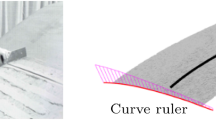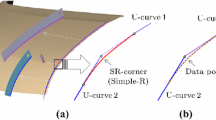Abstract
This paper presents a new method for reconstructing a surface model from scanned data as a \(\mathrm{C}^0\) composite surface. The surface is represented by intersecting underlying surfaces (U-surfaces), which are reconstructed from their respective parts segmented according to sweep-based modeling. However, even if each U-surface is successfully reconstructed, a surface model for the scanned data cannot be guaranteed to be desirably represented by a composite surface of those U-surfaces. Therefore, the proposed method reconstructs adjacent U-surfaces such that their intersecting curve represents part of feature lines, which are slightly offset from the scanned data, and has as small a torsion as possible. Compared with conventional approaches that naively fit a single patch to whole or some segmented parts, the method provides a guiding principle for the generation of surface models that are more suitable for styling design. The experimental results demonstrate that desirable models can be generated from real-world scanned data.


















Similar content being viewed by others
References
Bloomenthal M (1988) Approximation of sweep surfaces by tensor product B-splines. Technical Report UUCS-88-008, University of Utah, Salt Lake City
Bobenko AI, Schöder P (2005) Discrete Willmore Flow. In: Desbrun M, Pottmann H (eds) Eurographics Symposium on Geometry Processing. The Eurographics Association, Genoa, pp 101–110. https://doi.org/10.2312/SGP/SGP05/101-110
Brent RP (1973) Algorithms for minimization without derivatives. Prentice-Hall, Englewood Cliffs
Burchard H, Ayers J, Frey W, Sapidis N (1994) Approximation with aesthetic constraints. In: Sapidis NS (ed) Designing fair curves and surfaces. SIAM, Philadelphia, pp 3–28
Chung K, Wang W (1996) Discrete moving frames for sweep surface modeling. In: Proceedings of pacific graphics ’96, pp 159–173
Farin G (2006) Class A Bézier curves. Comput Aided Geom Des 23(7):573–581. https://doi.org/10.1016/j.cagd.2006.03.004
Hildebrandt K, Polthier K (2007) Constraint-based fairing of surface meshes. In: Belyaev A, Garland M (eds) Geometry processing. The Eurographics Association, Genoa, pp 203–212. https://doi.org/10.2312/SGP/SGP07/203-212
Hildebrandt K, Polthier K, Wardetzky M (2005) Smooth feature lines on surface meshes. In: Eurographics symposium on geometry processing, pp 85–90
Hoschek J, Lasser D (1993) Fundamentals of computer aided geometric design. A K Peters, Ltd, Wellesley
Inoue J, Harada T, Hagihara T (2009) An algorithm for generating log-aesthetic curved surfaces and the development of a curved surfaces generation system using VR. In: International association of societies of design research, Seoul, pp 2513–2522
Joshi P, Séquin C (2007) Energy minimizers for curvature-based surface functionals. Comput Aided Des Appl 4(5):607–617. https://doi.org/10.1080/16864360.2007.10738495
Kamaike M (2013) Automotive design history, theory & practice (in Japanese). Miki Press, Tokyo (ISBN 4895226115)
Lin F, Hewitt WT (1994) Expressing Coons–Gordon surfaces as NURBS. Comput Aided Des 26(2):145–155. https://doi.org/10.1016/0010-4485(94)90035-3
Mehlum E, Tarrou C (1998) Invariant smoothness measures for surfaces. Adv Comput Math 8(1):49–63. https://doi.org/10.1023/A:1018931910836
Meier H, Nowacki H (1987) Interpolating curves with gradual changes in curvature. Comput Aided Geom Des 4:297–305. https://doi.org/10.1016/0167-8396(87)90004-5
Moreton HP, Séquin CH (1992) Functional optimization for fair surface design. Comput Graph 26(2):167–176. https://doi.org/10.1145/142920.134035
NLopt (Nonlinear optimization library, 2.4.2) (2014). http://ab-initio.mit.edu/wiki/index.php/NLopt
Piegl L, Tiller W (1997) The NURBS book, 2nd edn. Springer, Berlin
Pottmann H, Wagner M (1998) Contributions to motion based surface design. Int J Shape Model 4(3 & 4):183–196. https://doi.org/10.1142/S0218654398000131
Tsuchie S (2017) Reconstruction of underlying curves with styling radius corners. Vis Comput 9(33):1197–1210. https://doi.org/10.1007/s00371-016-1282-4
Tsuchie S (2017) Reconstruction of underlying surfaces from scanned data using line of curvature. Comput Graph 68:108–118. https://doi.org/10.1016/j.cag.2017.08.015
Tsuchie S, Hosino T, Higashi M (2014) High-quality vertex clustering for surface mesh segmentation using student-t mixture model. Comput Aided Des 46:69–78. https://doi.org/10.1016/j.cad.2013.08.019
Várady T (2008) Automatic procedures to create cad models from measured data. Comput Aided Des Appl 5(5):577–588. https://doi.org/10.3722/cadaps.2008.577-588
Wang W, Joe B (1997) Robust computation of the rotation minimizing frame for sweep surface modeling. Comput Aided Des 29(5):379–391. https://doi.org/10.1016/S0010-4485(96)00077-2
Wang W, Jüttler B, Zheng D, Liu Y (2008) Computation of rotation minimizing frames. ACM Trans Graph 27(2):246–251. https://doi.org/10.1145/1330511.1330513
Westgaard G, Nowacki H (2001) Construction of fair surfaces over irregular meshes. In: Proceedings of the sixth ACM symposium on solid modeling and applications, pp 88–98. https://doi.org/10.1145/376957.376969
Ziatdinov R (2012) Family of superspirals with completely monotonic curvature given in terms of gauss hypergeometric function. Comput Aided Geom Des 29(7):510–518. https://doi.org/10.1016/j.cagd.2012.03.006
Zorin D (2005) Curvature-based energy for simulation and variational modeling. In: Proceedings of the international conference on shape modeling and applications, pp 196–204. https://doi.org/10.1109/SMI.2005.14
Author information
Authors and Affiliations
Corresponding author
Additional information
Publisher's Note
Springer Nature remains neutral with regard to jurisdictional claims in published maps and institutional affiliations.
Rights and permissions
About this article
Cite this article
Tsuchie, S. Reconstruction of intersecting surface models from scanned data for styling design. Engineering with Computers 37, 211–222 (2021). https://doi.org/10.1007/s00366-019-00817-x
Received:
Accepted:
Published:
Issue Date:
DOI: https://doi.org/10.1007/s00366-019-00817-x




